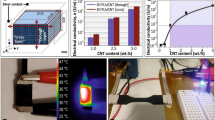Abstract
Two series of gold nanoparticles/graphene/polyurethane composite films were prepared using a solution mixing method. The first series was of constant loading of graphene/polyurethane with varying levels of gold nanoparticles (AuNPs), while the second was of varying graphene content with constant loading of AuNPs. The electrical conductivity of the AuNPs/graphene/polyurethane composites was determined using the two-point probe method. For the first series, a maximum conductivity of 0.424 S cm−1 was achieved with a 5% AuNPs/5% graphene/polyurethane composite, and for the second, a maximum conductivity of 1.388 S cm−1 was achieved with a 5% AuNPs/15% graphene/polyurethane composite. The composites were characterized by Fourier transform infrared spectroscopy, scanning electron microscopy, differential scanning calorimetry, thermogravimetric analysis, and tensile testing methods. Tensile strengths and thermogravimetric analyses showed, respectively, acceptable mechanical properties and thermal stability of the parent polyurethanes. Furthermore, cytotoxicity assay tests evidenced that AuNPs/graphene/polyurethane composites were not cytotoxic to living cells in vitro and, consequently, potentially useful in biomedical applications.








Similar content being viewed by others
References
Jagur-Grodzinski J (2012) Biomedical applications of electrically conductive polymeric systems. e-Polymers 12(1):722–740
Granström M, Inganäs O (1995) Electrically conductive polymer fibres with mesoscopic diameters: 1. Studies of structure and electrical properties. Polymer 36(15):2867–2872
Kim DH et al (2007) Effect of immobilized nerve growth factor on conductive polymers: electrical properties and cellular response. Adv Funct Mater 17(1):79–86
Kaur G et al (2015) Electrically conductive polymers and composites for biomedical applications. RSC Adv 5(47):37553–37567
Wang W et al (2014) One-pot fabrication and thermoelectric properties of Ag nanoparticles–polyaniline hybrid nanocomposites. RSC Adv 4(51):26810–26816
Gunatillake PA et al (2003) Designing biostable polyurethane elastomers for biomedical implants. Aust J Chem 56(6):545–557
Gunatillake PA et al (2000) Poly (dimethylsiloxane)/poly (hexamethylene oxide) mixed macrodiol based polyurethane elastomers. I. Synthesis and properties. J Appl Polym Sci 76(14):2026–2040
Gogolewski S (1989) Selected topics in biomedical polyurethanes. A review. Colloid Polym Sci 267(9):757–785
Kathalewar MS et al (2013) Non-isocyanate polyurethanes: from chemistry to applications. RSC Adv 3(13):4110–4129
Hsu S-H, Tang C-M, Tseng H-J (2008) Gold nanoparticles induce surface morphological transformation in polyurethane and affect the cellular response. Biomacromolecules 9(1):241–248
Shukla R et al (2005) Biocompatibility of gold nanoparticles and their endocytotic fate inside the cellular compartment: a microscopic overview. Langmuir 21(23):10644–10654
Daniel M-C, Astruc D (2004) Gold nanoparticles: assembly, supramolecular chemistry, quantum-size-related properties, and applications toward biology, catalysis, and nanotechnology. Chem Rev 104(1):293–346
Matte HR, Subrahmanyam K, Rao C (2009) Novel magnetic properties of graphene: presence of both ferromagnetic and antiferromagnetic features and other aspects. J Phys Chem C 113(23):9982–9985
Sun X et al (2013) Developing polymer composite materials: carbon nanotubes or graphene? Adv Mater 25(37):5153–5176
Potts JR et al (2011) Graphene-based polymer nanocomposites. Polymer 52(1):5–25
Mittal V, Nuzzo R, Kroto H (2012) Polymer-graphene nanocomposites. Royal Society of Chemistry, London
Stankovich S et al (2006) Graphene-based composite materials. Nature 442(7100):282–286
Kaur G et al (2015) Graphene/polyurethane composites: fabrication and evaluation of electrical conductivity, mechanical properties and cell viability. RSC Adv 5(120):98762–98772
Hsu S-H, Lin Z-C (2004) Biocompatibility and biostability of a series of poly(carbonate)urethanes. Colloids Surf B 36(1):1–12
Shan C et al (2010) Graphene/AuNPs/chitosan nanocomposites film for glucose biosensing. Biosens Bioelectron 25(5):1070–1074
Simmons A et al (2004) Long-term in vivo biostability of poly(dimethylsiloxane)/poly(hexamethylene oxide) mixed macrodiol-based polyurethane elastomers. Biomaterials 25(20):4887–4900
Choi J et al (2013) Facile solvothermal preparation of monodisperse gold nanoparticles and their engineered assembly of ferritin-gold nanoclusters. Langmuir 29(50):15698–15703
Turcheniuk K, Boukherroub R, Szunerits S (2015) Gold–graphene nanocomposites for sensing and biomedical applications. J Mater Chem B 3(21):4301–4324
Mudumba R, Padsalgikar AD, Littler SW (2006) Evaluation of aqueous extracts from Elast-Eon polymers for methylene dianiline (MDA) by high-performance liquid chromatography (HPLC). Aust J Chem 58(12):845–850
Hernandez R et al (2008) In vitro oxidation of high polydimethylsiloxane content biomedical polyurethanes: correlation with the microstructure. J Biomed Mater Res Part A 87(2):546–556
Polavarapu L et al (2009) Optical-limiting properties of oleylamine-capped gold nanoparticles for both femtosecond and nanosecond laser pulses. ACS Appl Mater Interfaces 1(10):2298–2303
Ramaraj B (2007) Electrical and mechanical properties of thermoplastic polyurethane and polytetrafluoroethylene powder composites. Polym Plast Technol Eng 46(6):575–578
Compton OC, Nguyen ST (2010) Graphene oxide, highly reduced graphene oxide, and graphene: versatile building blocks for carbon-based materials. Small 6(6):711–723
Ahmad R et al (2015) Nanocomposites of gold nanoparticles@ molecularly imprinted polymers: chemistry, processing, and applications in sensors. Chem Mater 27(16):5464–5478
Zadeh EM et al (2014) Physical and thermal characterization of graphene oxide modified gelatin-based thin films. Polym Compos 35(10):2043–2049
Xu Y et al (2008) Flexible graphene films via the filtration of water-soluble noncovalent functionalized graphene sheets. J Am Chem Soc 130(18):5856–5857
Yousefi N et al (2012) Self-alignment and high electrical conductivity of ultralarge graphene oxide–polyurethane nanocomposites. J Mater Chem 22(25):12709–12717
Rana S, Cho JW, Tan LP (2013) Graphene-crosslinked polyurethane block copolymer nanocomposites with enhanced mechanical, electrical, and shape memory properties. RSC Adv 3(33):13796–13803
Kotzar G et al (2002) Evaluation of MEMS materials of construction for implantable medical devices. Biomaterials 23(13):2737–2750
Acknowledgements
The authors would like to acknowledge Dr Ajay Padsalgikar of St Jude Medical for providing Elast-Eon™ samples and Mark Greaves for his help with performing SEM.
Author information
Authors and Affiliations
Corresponding authors
Ethics declarations
Conflict of interest
We wish to confirm that there are no known conflicts of interest associated with this publication and there has been no significant financial support for this work that could have influenced its outcome.
Rights and permissions
About this article
Cite this article
Al-Attabi, N.Y., Kaur, G., Adhikari, R. et al. Preparation and characterization of highly conductive polyurethane composites containing graphene and gold nanoparticles. J Mater Sci 52, 11774–11784 (2017). https://doi.org/10.1007/s10853-017-1335-8
Received:
Accepted:
Published:
Issue Date:
DOI: https://doi.org/10.1007/s10853-017-1335-8




